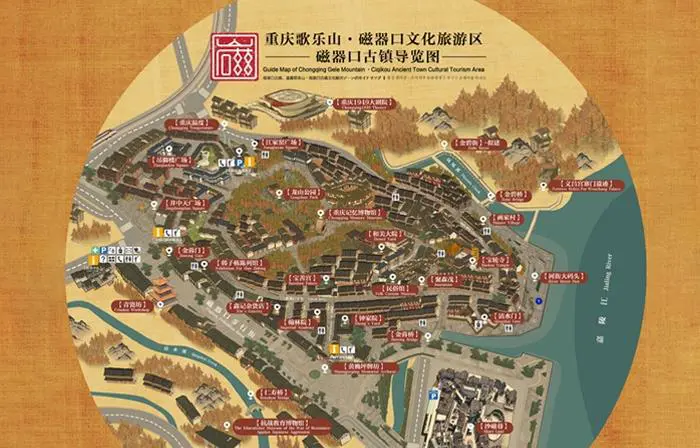Layout of tourist attractions in ciqikou ancient town
Ciqikou ancient town takes Ciqikou main street and cross street as the skeleton, and 42 laneways develop perpendicular to the main street and cross street to the edge of Maanshan ridge and gully, forming a dendritic plane pattern [5]. Among them, the main scenic spots in Huangjueping Lane 1 include Huangjueping Archway, Hanlin Academy and Zhongjiayuan. The main attractions in Ciqikou Main Street are Baoshan Palace, etc. The main attractions in Ciqikou Crossstreet are Baolun Temple and the image of a young woman urinating a child. The main attractions in Yu Wang Lane are Han Zidong Exhibition Hall and so on.
Structure ciqikou ancient town has a total area of 325,000 square meters, of which the well-preserved core area of the ancient town is distributed in the east and southeast of Maanshan, covering an area of 143,000 square meters. The ancient town is built on the mountain, with Ciqikou main street and cross street as the skeleton, and 42 lanes are perpendicular to the main street and cross street and develop in a dendritic way to the edge of Maanshan ridge and gully, forming a dendritic plane pattern with obvious characteristics. The main street and the horizontal street are 3-6.5 meters wide, connecting the Jialing River Waterway Terminal, Baolun Temple and the peripheral traffic trunk roads. The roadway is 1.5-4.5 meters wide, which conforms to the flexible layout of the terrain and is eclectic. The street-roadway-house constitutes a three-level spatial structure of public space, semi-public space and private space, forming a clear basic model of social organization in the block [5].
Features ciqikou ancient town is the only ancient town with the largest scale and the most traditional folk houses, folk customs and folk customs in Chongqing [5]. The ancient town has traditional residential buildings, stone stairs, streets and alleys, and remains of the temple palace view, which is a natural museum of residential buildings in Bayu Mountain [5]. Temple buildings in ancient towns adopt the architectural model of "ancient temples in deep mountains", most of which are close to mountains and rivers, and their buildings are integrated with nature, conveying the connotation of the integration of architecture and nature and the unity of man and nature; Most of the residential houses are antique buildings rebuilt by the government for the purpose of setting up tourism, and they are also built on the mountain, walking along the water and gathering in points, which is a typical mountain residential community; The commercial buildings in the ancient town still retain the traditional architectural structure, mostly made of bamboo and wood. The structural forms are mainly bucket-piercing and binding, and the layout is flexible to adapt to the changes of terrain. Most of the shops along the street are three rooms in one room, and the back rooms of the shops are usually quadrangles, and most of them are the residences of large merchants. The architectural decoration of ancient towns mostly adopts the color of building materials themselves, with the aim of making the building groups have a more unified sense; In terms of architectural decoration, it is mainly reflected in overhangs and doors and windows. Its exquisite carving patterns and various shapes of graphics make the overall image of the building glorious.





